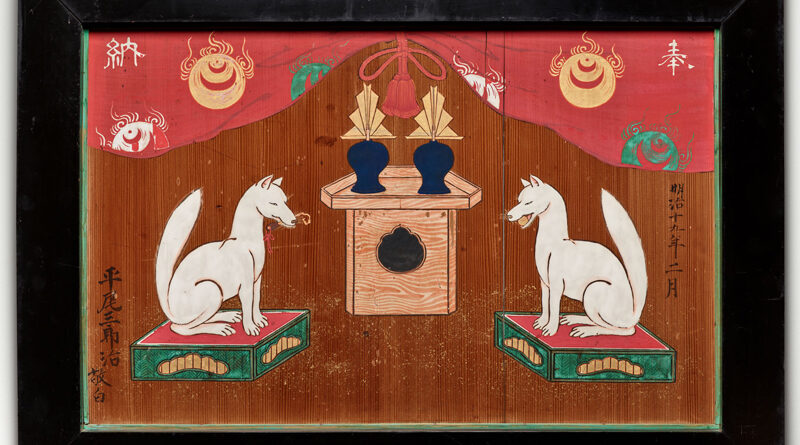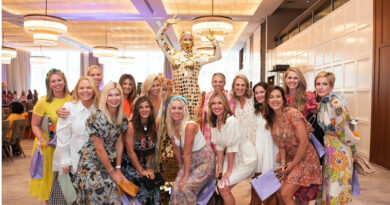Crow Museum of Asian Art of the University Of Texas At Dallas To Present Japan, Form & Function: The Montgomery Collection April 15, 2023-April 14, 2024
Covering 5,000 years of Japanese history with 240-plus stunning and rarely seen works, this landmark exhibition – focusing on beloved Mingei folk art and more – marks the first time the Crow Museum of Asian Art will dedicate its entire museum to a sole presentation
(Featured image: Votive painting (ema) with two shrine foxes (kitsune) making an offering.)*
A landmark exhibition featuring numerous works never before seen in the U.S., Japan, Form & Function: The Montgomery Collection, will open Saturday, April 15, 2023, at the Crow Museum of Asian Art in the downtown Dallas Arts District (2010 Flora St., Dallas, TX 75201). Encompassing six galleries and over 11,000 square feet, the exhibition features nearly 250 stunning works of Japanese art to be presented in major themes and categories. This marks the first time that the Crow Museum will dedicate its entire museum to one exhibition over an extended period. Free and open to the public, Japan, Form & Function will be on view through April 14, 2024.
Carefully selected from more than 1,000 objects cultivated over Jeffrey Montgomery’s lifetime, the Switzerland-based collection has been regarded as arguably the largest, most comprehensive – and possibly one of the most valuable – private compilations of traditional Japanese works outside of the country. Japan, Form & Function covers 5,000 years of Japanese history, featuring works spanning from the early Jōmon period (5,000-3,520 BCE) to the mid-20th centuries.
“For the first time in the Crow Museum’s 25-year history, we are devoting every inch of gallery space – and an entire year – to showcase Jeffrey Montgomery’s beloved collection of traditional Japanese art and Mingei that he carefully assembled and nurtured over past decades,” said Amy Lewis Hofland, senior director of the Crow Museum of Asian Art of The University of Texas at Dallas. “We’re so grateful that visitors from North Texas and beyond will get an opportunity to immerse themselves in the rich culture, history and artisan craftmanship that is so exquisitely illustrated in the Montgomery Collection. This exhibition creates the opportunity to ‘see’ Japan at its height of form and function.”
The collection emphasizes the Mingei Movement, an influential exploration of Japanese folk crafts that began in the 1920s when the aesthetic beauty and simplicity of everyday, handcrafted items were celebrated. While works were originally not made with artistic intent foremost in mind, they reveal high aesthetic qualities that reverberate with modernist ideals of design, abstraction and pattern. The wide range of objects include metalware, textiles such as kimonos and futon covers, ceramics, wooden sculptures, lacquerware, paintings, banners, hanging screens and more.

Most works from the Montgomery Collection can be identified as Japanese folk art comprising a wide range of media, formats and patterns, which typically differ from region to region. Various influences and styles have impacted each area of the vast country, and the mass production of objects for daily use testifies to the exquisite craftsmanship and the stunning regional diversity that have existed in Japan for centuries. Two key elements are recurrent throughout the exhibition: form and function. Far from referring uniquely to the overall shape of the objects by form, the intended functions of the various components are also revealed.
The variety of materials shown in the exhibition – ceramic, textiles, metalware, wood, paper, wooden sculptures, lacquerware, paintings and more – and the origin of the works scattered over countless provinces provide an encyclopedic range of patterns, designs, motifs, compositions and outlines. Moreover, these objects all served a specific purpose within a cultural context and mostly fit into everyday life practices. They are representative of the region they were produced in and had very specific functions – water jars, futon covers, tea kettles, kimonos and ceremonial banners.
“I’m known as a collector for what I’m doing, however I personally consider myself as a keeper than a collector because I wish to keep a tradition and to expose it to other generations, especially young people. This exhibition is a culmination of a life’s work and passion that reflects my enormous interest and reverence for Japanese culture,” said Jeffrey Montgomery of his collection and the exhibition.
Each gallery presents one or more themes from a specific region of Japan – starting from the very South in Okinawa and the old Ryūkyū Kingdom, and ending in Tōhoku, the northernmost region of Honshū. Some specific themes approached in the exhibition are the Chinese influence at the time of the Ryūkyū Kingdom (Okinawa), the Six Ancient Kilns, symbols and iconography in Shintoism, and the Mingei Movement.
Exquisite examples of ceramics can be seen in the form of water containers, storage jars, chargers, dishes, bowls, sake bottles next to flasks in stoneware and porcelain, and oil drip plates.
This is not the Montgomery Collection’s first stop in Texas. As part of the “Sun and Star 1996” festival in 1996, a 100-day celebration of Japanese culture that was held in the Dallas/Fort Worth region, a sampling of the collection was featured. The Montgomery Collection has grown in size and significance since that time.
The Crow Museum of Asian Art is the organizing institution for Japan, Form & Function: The Montgomery Collection, with financial support from the Dallas Tourism Public Improvement District. Official nominal support of the exhibition is provided by the Government of Japan Agency for Cultural Affairs and the Consulate-General of Japan in Houston.
The curator of the exhibition is Luigi Zeni. An accompanying complimentary gallery map will be available for visitors.
The Mingei Movement
One of the main sections of the exhibition is dedicated to exponents of the Mingei Movement, which brought a revival in the awareness and appreciation of Japanese local craftsmanship in a period of modernization of the country and swift rise of consumerism. The Mingei Movement was founded at the end of the Taishō period (1912-1926), at a time when Japan was transitioning from a democratic government towards the nationalistic regime introduced in the Shōwa period (1926-1989). The founder of this movement was the philosopher and scholar Yanagi Sōetsu (1889-1961), who stood against the industrialization and modernization of the country based on the Western model. He claimed that mingei (literally “folk art”) reflected Indigenous and pure Japanese folk production with clear regional differences, typical and unique to Japan, whose richness and renown they contributed to establish. As handmade mass-produced wares, mingei products responded to the needs of everyday life, yet with high artisanal quality. The members of the Mingei Movement, such as the ceramists Kawai Kanjirō (1890-1966), Hamada Shōji (1894-1978) and the British potter, Bernard Leach (1887-1979), were not only promoters of the Movement, but also artists; their works are exhibited in the Jade Room of the Crow Museum.
GENERAL INFORMATION
The Crow Museum of Asian Art of The University of Texas at Dallas is open Tuesdays-Sundays (11 a.m.-5 p.m.). The museum is closed on Mondays. Admission is free and suggested donations are $12 for adults. For more information, please go to crowmuseum.org or call 214-979-6430.
About the Crow Museum of Asian Art of the University of Texas at Dallas. Founded in 1998, the Crow Museum of Asian Art of The University of Texas at Dallas inspires and promotes learning and dialogue about the arts and cultures of Asia through its exhibitions, the research and preservation of its collections, artistic and educational programming, and visitor experience and engagement. The museum accomplishes this in accordance with the highest professional standards and through collaboration with diverse audiences and community partners within North Texas and throughout the world. Free and open to the public, this museum celebrates the arts and cultures of Asia – from ancient eras to contemporary times – through a variety of permanent and traveling exhibitions that showcase the arts of a multitude of countries. With an array of beautiful spaces and galleries, the museum offers a serene setting for quiet reflection in the heart of the Dallas Arts District. Learn more at crowmuseum.org.
About the Montgomery Collection. The Montgomery Collection is widely acknowledged to be the largest and finest collection of Japanese folk art outside Japan. The Swiss collector Jeffrey Montgomery has spent more than 40 years traveling around the world acquiring works that today total approximately 1,100 works in various media. Among others features, the collection reflects his personal taste and interest in the functional as well as the sculptural qualities of the objects. Montgomery started collecting Japanese folk art for his own enjoyment, which then developed into a passion that continues today. His collection came to the attention of scholars and curators leading to requests to exhibit his collection by various museums and galleries, which in turn led to an international awareness of the collection. Over the years, specialized parts of the collection have been subjects of more than thirty exhibitions at venues such as the Victoria & Albert Museum in London, the Museum Bellerive in Zurich, The Musée des Arts Asiatiques in Nice, the Japan Society Gallery and Bard Graduate Center in New York and numerous other venues both in Switzerland and abroad; all received with enthusiastic attendance and reviews. In addition, the collection has been published in numerous books and catalogues, with essays by noted scholars, providing some of the best reference works for Japanese folk art available in European languages.
*Courtesy photo
(This Philanthropy Lifestyles eBuzz post courtesy Crow Museum of Asian Art of the University of Texas at Dallas.)




